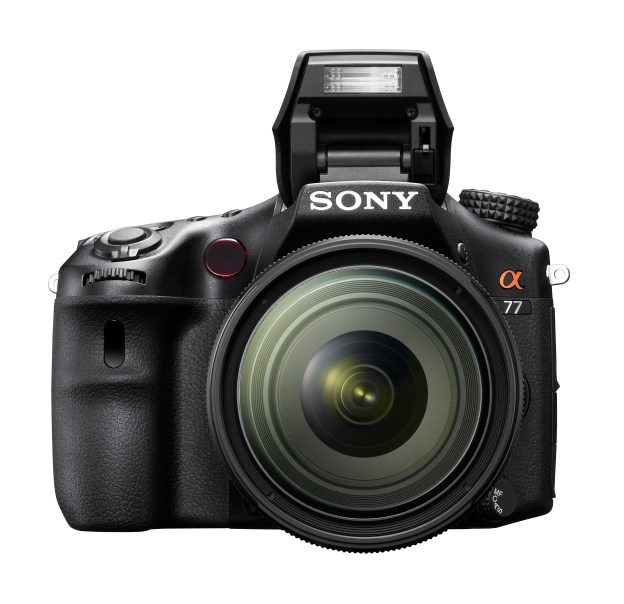
Make sure to check out our full review of the Sony Alpha SLT-A77.
Don’t feel ashamed if you thought the new Sony Alpha A77 is a DSLR. But it’s not. It’s a glimpse as to what may make DSLRs obsolete.
The A77 is exactly the kind of expensive ($2000 kit), hulking (weather-sealed magnesium body) piece of camera hardware with ridiculous specs (24.3 megapixel APS-C sensor, ISO 50-16,000) that photographers everywhere drool over.
But the coolest part, the real game-changing bit of tech, is inside: the A77 has no traditional mirror, which makes it something altogether different than your average DSLR. Instead, Sony’s designed a translucent replacement that offers ridiculous fast autofocusing with less bulk.

The ‘reflex’ part of a digital single lens reflex camera refers to the mirror situated behind the lens that both sends an image to the viewfinder and, more importantly, allows the laser-fast autofocusing of the modern DSLR. If you’ve ever wondered why a point-and-shoot takes a second to fire while a DSLR snaps away near-instantaneously, it’s because of that mirror system.
The only problem is, having a mirror flip-flopping around inside a camera means that camera must be big enough to hold it, and offers more complexity and more parts to break. Additionally, when a camera is in burst or video mode, the mirror stays flipped out of the way, making continuous focus difficult.
Sony’s new tech goes a long way towards eliminating all of that. Basically, the translucent mirror setup the A77 has reflects just enough light for focusing needs while letting the image pass through to the sensor normally. This has the potential to be more compact, but more importantly means that the camera’s phase-detection autofocus system always has a source to focus on. DSLRs have been already available with continuous autofocus, but they are forced to use a less accurate sensor-based solution when in video or burst mode. The A77’s translucent mirror allows it to always use its most accurate focusing system.
It’s a huge breakthrough for DLSR videographers, who now have a viable option for seriously fast and accurate focusing (read: great for sports). It also allows the camera to have a crazy burst rate: 12 frames per second at 24.3-megapixels, far faster than any DSLR, even those that use lower resolutions.
The A77 isn’t the first Sony camera to use the translucent mirror tech; the A55 and A33 had it last year. But with a vastly improved sensor, a more powerful Bionz image processor and the ability to shoot AVCHD Progressive-format HD (1080p at 60fps!), the A77 takes full advantage of the tech.

That aside, the new mirror tech adds a bit of a flicker to the screen while shooting video, although until we get our hands on one it’s tough to tell how annoying that may or may not be. Finally, until test models start going out, the verdict is still out on how great images and video turn out to be.
But on paper, the A77 is a wonderful addition to the current camera realm. Along with the Micro Four-Thirds format, there’s another seriously viable option for an interchangable-lens camera that isn’t a DSLR. For a lot of people, that’s going to be a very good thing.
For more specs and info, check out Sony’s press release.


